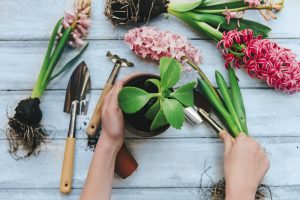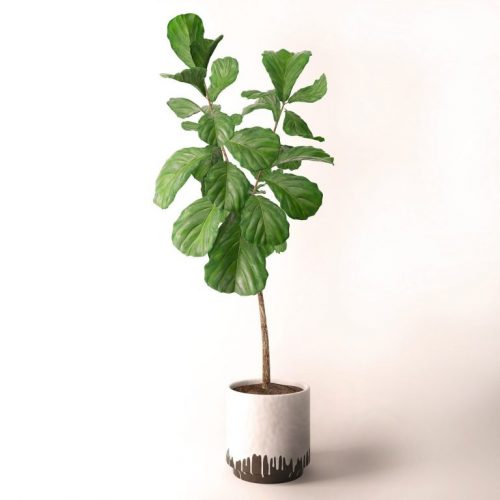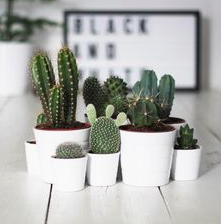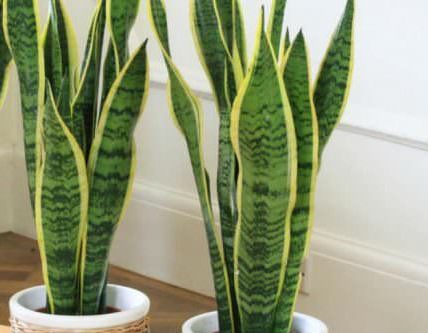8 Indoor Plants You Should Know About

It’s not necessary anymore to have a terrace or garden to be able to enjoy your plants. There are many varieties of indoor plants that you can have in your home. Some of these don’t even need much care, so your busy life or little time to spare on plants aren’t really valid excuses.
Having said that, you will need to think about the space you have available, to buy the right size plants, since each different type of plant needs its own set space or width to grow.
If you have extra space in your house, you could create a small garden. Or another possible option is to make use of the space below the stairs to keep your plants.
In this article we will show you the advantages to having indoor plants, as well as 8 suggestions for excellent indoor plants you could try in your home.
Advantages to having indoor plants in your home
Here we give you some of the main advantages in having indoor plants:
- Increases the oxygen inside the home, absorbing carbon dioxide. This process is known as photosynthesis. Remember that this process takes place at night. So, if you have plants, the quality of the air inside your home will be improved.
- Adds humidity to the air. This hydrates your skin and clears your airways.
- Increases the sense of vitality.
Flowers seem intended for the solace of ordinary humanity
-John Ruskin-
- Their care and attention reduces stress. That is to say, they are conducive to having a relaxing environment.
- Some plants, such as cacti, absorb electromagnetic radiation. This helps you to avoid the secondary effects of these waves, such as alterations in your sleep patterns, irritability or headaches.
- Contributes to your interior decor, giving an original touch and a splash of color.
- Freshens and scents the air. They can be an excellent substitute for scented candles or incense.
Characteristics and care for some indoor plants
Here are some examples of plants that are commonly seen indoors. These plants are particularly pleasing to the eye. You shouldn’t forget that most plants cope with a lack of water better than an excess. Although as you’ll see, caring for them isn’t necessarily too complicated.
Fig
This is one of the most commonly used indoor plants. You can find hundreds of varieties within the same species.
They adapt easily to surroundings with high temperatures, and don’t need much watering. A couple of times a week will be sufficient.
 Ivy
Ivy
This is a very hardy plant that needs a lot of ambient light, but never direct sunlight. You should tone down direct light using curtains.
A word of advice: let the upper layer of soil dry out between waterings.
Bonsai
Not all types are suitable for indoors. These are small trees and bushes that have been grown using cultivation techniques so they stay the same size.
Due to the fact that they don’t change and don’t keep growing bigger, it can be difficult to know how old the plant is.
The ideal circumstances for a bonsai would be in a room where there is a lot of natural light and without any breeze. You can transplant them roughly every two years to freshen up the soil or potting mix.
Cactus
These are really outdoor plants, but can live indoors without any problems. They easily adapt to their environment.
They are very hardy, and barely need any water. In wintertime they can sometimes need a little more water, since the air can be a little dryer during those months due to the use of heating in the home.

It’s recommended that you put holes in the base of the pot to make drainage easier. There are two varieties: desert cactus and tropical cactus. Both types of cactus produce beautiful flowers.
Fruit salad plant (Monstera deliciosa)
These need moderate light and watering. Although they tolerate a dry environment reasonably well, it’s good to give them a light spray of water relatively frequently. This plant is very pretty.
Other indoor plants: succulents
In general, these are known for their fleshy leaves, in which water is stored. (Also stored in the stem.) The majority need to be in direct sunlight at least some of the time.
Some of the best known succulents are:
Aloe vera
This is well known for its curative properties and because it almost doesn’t need any care. You shouldn’t expose it to excessive cold or too much humidity. Remember, it can go for long spells without being watered.
Be a little careful of the spikes that protrude from the sides of the leaves.
Sansevieria (also known as mother in law’s tongue)
This is very hardy, and barely needs attention. It adapts itself to its surroundings. It needs very little light and water.

Sansevieria plants / i.pinimg.com
Mexican gem (Echeveria elegans)
This is known for staying small. Its pale green-blue fleshy leaves form tight rosettes. It doesn’t endure a very humid atmosphere too well.
Something very important and curious – it tolerates contamination very well.
So there are some ideas for indoor plants for you. Why not go for it? Decorate your house and fill it with color. Also, as we’ve mentioned, plants contribute to your well-being.
It’s not necessary anymore to have a terrace or garden to be able to enjoy your plants. There are many varieties of indoor plants that you can have in your home. Some of these don’t even need much care, so your busy life or little time to spare on plants aren’t really valid excuses.
Having said that, you will need to think about the space you have available, to buy the right size plants, since each different type of plant needs its own set space or width to grow.
If you have extra space in your house, you could create a small garden. Or another possible option is to make use of the space below the stairs to keep your plants.
In this article we will show you the advantages to having indoor plants, as well as 8 suggestions for excellent indoor plants you could try in your home.
Advantages to having indoor plants in your home
Here we give you some of the main advantages in having indoor plants:
- Increases the oxygen inside the home, absorbing carbon dioxide. This process is known as photosynthesis. Remember that this process takes place at night. So, if you have plants, the quality of the air inside your home will be improved.
- Adds humidity to the air. This hydrates your skin and clears your airways.
- Increases the sense of vitality.
Flowers seem intended for the solace of ordinary humanity
-John Ruskin-
- Their care and attention reduces stress. That is to say, they are conducive to having a relaxing environment.
- Some plants, such as cacti, absorb electromagnetic radiation. This helps you to avoid the secondary effects of these waves, such as alterations in your sleep patterns, irritability or headaches.
- Contributes to your interior decor, giving an original touch and a splash of color.
- Freshens and scents the air. They can be an excellent substitute for scented candles or incense.
Characteristics and care for some indoor plants
Here are some examples of plants that are commonly seen indoors. These plants are particularly pleasing to the eye. You shouldn’t forget that most plants cope with a lack of water better than an excess. Although as you’ll see, caring for them isn’t necessarily too complicated.
Fig
This is one of the most commonly used indoor plants. You can find hundreds of varieties within the same species.
They adapt easily to surroundings with high temperatures, and don’t need much watering. A couple of times a week will be sufficient.
 Ivy
Ivy
This is a very hardy plant that needs a lot of ambient light, but never direct sunlight. You should tone down direct light using curtains.
A word of advice: let the upper layer of soil dry out between waterings.
Bonsai
Not all types are suitable for indoors. These are small trees and bushes that have been grown using cultivation techniques so they stay the same size.
Due to the fact that they don’t change and don’t keep growing bigger, it can be difficult to know how old the plant is.
The ideal circumstances for a bonsai would be in a room where there is a lot of natural light and without any breeze. You can transplant them roughly every two years to freshen up the soil or potting mix.
Cactus
These are really outdoor plants, but can live indoors without any problems. They easily adapt to their environment.
They are very hardy, and barely need any water. In wintertime they can sometimes need a little more water, since the air can be a little dryer during those months due to the use of heating in the home.

It’s recommended that you put holes in the base of the pot to make drainage easier. There are two varieties: desert cactus and tropical cactus. Both types of cactus produce beautiful flowers.
Fruit salad plant (Monstera deliciosa)
These need moderate light and watering. Although they tolerate a dry environment reasonably well, it’s good to give them a light spray of water relatively frequently. This plant is very pretty.
Other indoor plants: succulents
In general, these are known for their fleshy leaves, in which water is stored. (Also stored in the stem.) The majority need to be in direct sunlight at least some of the time.
Some of the best known succulents are:
Aloe vera
This is well known for its curative properties and because it almost doesn’t need any care. You shouldn’t expose it to excessive cold or too much humidity. Remember, it can go for long spells without being watered.
Be a little careful of the spikes that protrude from the sides of the leaves.
Sansevieria (also known as mother in law’s tongue)
This is very hardy, and barely needs attention. It adapts itself to its surroundings. It needs very little light and water.

Sansevieria plants / i.pinimg.com
Mexican gem (Echeveria elegans)
This is known for staying small. Its pale green-blue fleshy leaves form tight rosettes. It doesn’t endure a very humid atmosphere too well.
Something very important and curious – it tolerates contamination very well.
So there are some ideas for indoor plants for you. Why not go for it? Decorate your house and fill it with color. Also, as we’ve mentioned, plants contribute to your well-being.







